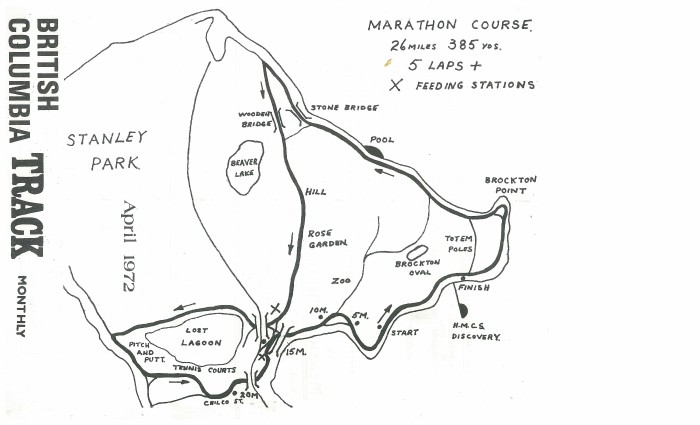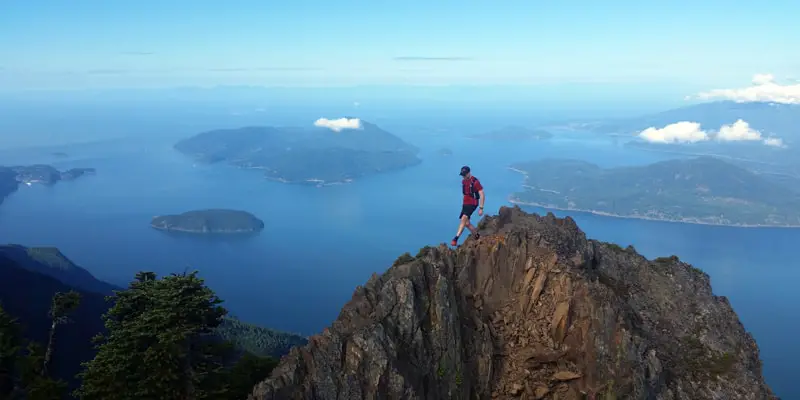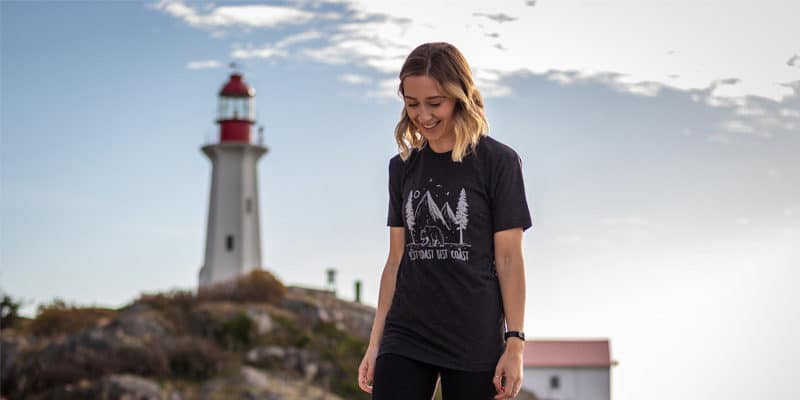I’m currently training for the 2013 BMO Vancouver Marathon and am one of six official bloggers. Each week I’m providing updates on my training and experience leading up to May 5. You can read my first three posts here, here and here.
On May 5 I’m running the BMO Vancouver Marathon with the hopes of posting a Boston Marathon qualifying time (BQ). Instead of another update on my training, I thought it would be fun to look briefly into the history of these two marathons, how they have evolved, and some interesting facts about each. Let’s start with Vancouver.
The BMO Vancouver Marathon
The very first Vancouver Marathon (then dubbed the British Columbia Marathon) was run in May 1972. At the time, the marathon was still not very popular, and female participation was limited. In fact, 1972 is also the first year the Boston Marathon officially allowed female participants.The first race was a simple course consisting of 5 loops of Stanley Park. I was lucky to get my hands on a copy of the original course map (pictured top, click to enlarge). All the course maps will soon be available on runvan.org which is dedicated to the Vancouver International Marathon Society.
In 1973, the race was renamed to the Lions Gate Road Runners International Marathon and was again run around Stanley Park. In 1979, the course expanded out of Stanley Park and began to include the roads of downtown. There were various iterations of this course until the 90’s when the course changed entirely again. For most of the 90’s the course actually included North Vancouver, with runners doing a giant loop around the Burrard Inlet via the Lions Gate and Ironworkers bridges. In the 2000’s the course is what most people will remember, a course starting downtown, going through Stanley Park, over the Burrard Bridge into Kits and back downtown (with some variation). In 2012, a new exciting course was designed. For the first time in its history the Vancouver Marathon was a point-to-point race starting at Queen Elizabeth Park, wending out to UBC then due east towards downtown and over the Burrard Bridge, then around the Stanley Park seawall before finishing downtown.
Aside from the different courses that have been offered, the early days of the Vancouver Marathon are very interesting. RunningMagazine.ca put together a fantastic article in 2011 complete with some vintage photos which I recommend reading for a detailed history. Here’s an excerpt:
In their quiet way, those Lions Gate/Vancouver pioneers were visionaries. From the start, they designated their race “international,” positioning it away from the boring old-style local championships. They included women and masters, gave them full recognition, and even found sponsorship for them. They gave opportunity to other less likely groups of runners, like the visually challenged. And above all they chose to make their new race a marathon distance. That looks obvious in 2011, when every self-respecting city has to have its marathon, but it wasn’t obvious in 1972….
Look again at those dates. Vancouver arrived at the marathon party only eighteen months after New York City. It was there to welcome later arrivals like Berlin, Chicago, Toronto, Ottawa and London. It helped shape the sport’s culture of including everyone. It helped forge the sport’s other defining characteristic, the strong link between each race and its local community. At the same time as New York in the mid-1970s, Vancouver moved its start and finish and some of its course out of the Park and into downtown. It became an open city tour, not laps of an enclosed park (Stanley or Central Park) – exactly the key factor in transforming the New York City Marathon. The Vancouver Marathon was positioned as open and international, related to the city itself, not the closed and enclosed event of an inward-looking sporting federation.
From its humble beginnings it has grown to what is, depending on the year, often Canada’s largest marathon.
Fun Facts about the race
- The race is held on the first Sunday of May each year
- In the inaugural 1972 race, 32 of 46 runners completed 5 loops of Stanley Park
- They paid a $1 entry fee<
- In 2012 it was Canada’s largest marathon, with 4,234 runners completing the full marathon
- In 1983 runners were misdirected and ran an additional 561 yards
- Tom Howard (Canada) was the top male in the 1972 race with a time of 2:24:08
- Gezahgn Eshetu (Ethiopa) was the top male in the 2012 race with a time of 2:21:51
- Patricia Loveland (United States) was the top female in the 1972 race with a time of 3:39:23
- Ellie Greenwood (UK (now North Vancouver resident :) ) was the top female in 2012 with a time of 2:42:16
- Garry Henry (Australia) posted the fastest time in 1980 with a time of 2:13:14
The Boston Marathon
Everyone has heard of the Boston Marathon. It is the longest-standing annual marathon with the first race having taken place back in 1897.
From the Boston Athletic Association website:
After experiencing the spirit and majesty of the Olympic Marathon, B.A.A. member and inaugural US Olympic Team Manager John Graham was inspired to organize and conduct a marathon in the Boston area. With the assistance of Boston businessman Herbert H. Holton, various routes were considered, before a measured distance of 24.5 miles from Metcalf’s Mill in Ashland to the Irvington Oval in Boston was eventually selected. On April 19, 1897, John J. McDermott of New York, emerged from a 15-member starting field and captured the first B.A.A. Marathon in 2:55:10, and, in the process, forever secured his name in sports history.
In 1924, the B.A.A. moved the starting line from Ashland to Hopkinton. In 1927, the Boston Marathon course was lengthened to the full distance of 26 miles, 385 yards to conform to Olympic standards.
Due to its popularity, runners are forced to post a qualifying time at another recognized marathon event (like Vancouver) in order to compete. In 2012, those standards were made harder by 5 minutes for all age-groups.
Fun Facts about the race
- The race is held on Patriot’s Day, the third Monday of April
- The inaugural race was held in 1987, it is the world’s oldest annual marathon
- John J. McDermott of New York won the first race with a time of 2:55:10
- The event draws 500,000 spectators each year
- In 2011 Geoffrey Mutai (Kenya) won the Boston Marathon in a time of 2:03:02
- IAAF hasn’t granted world record status for Geoffrey’s run since the course doesn’t satisfy rules regarding elevation drop and start/finish separation
- Heartbreak Hill is an ascent over 600 m between the 32 and 34 km marks
- Katherine Switzer entered and completed the race in 1967, five years before women were officially allowed to compete in it
- The record for the world’s largest marathon was established in 1996, when 35,868 finishers participated in the 100th running
- John A. Kelley started a record 61 Boston Marathons and finished 58




